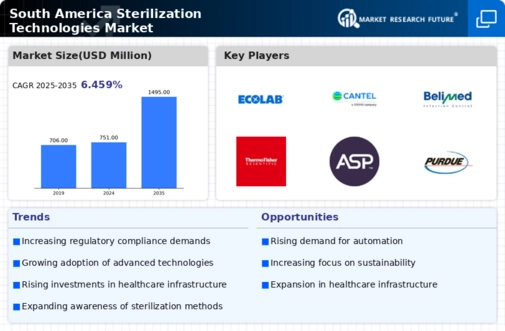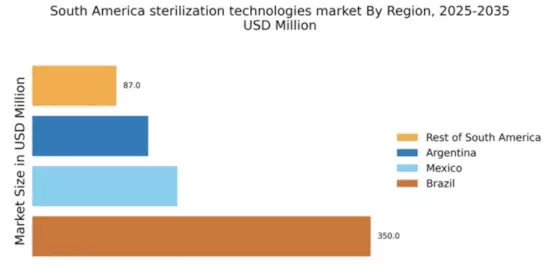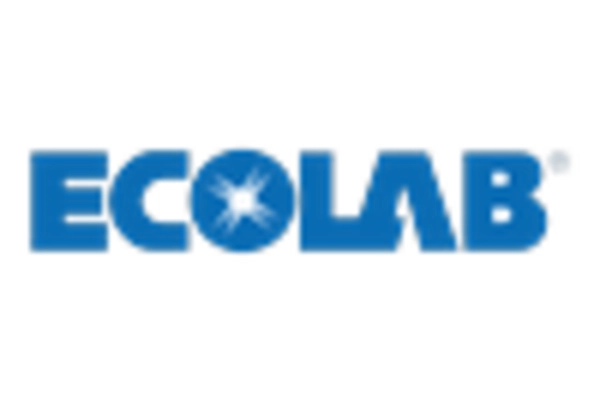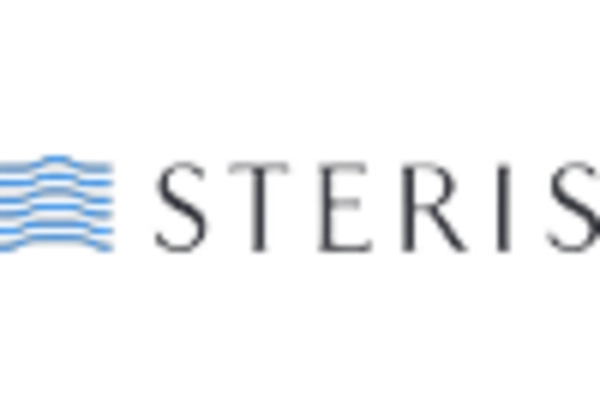Rising Healthcare Expenditure
The increasing healthcare expenditure in South America is a pivotal driver for the sterilization technologies market. As governments and private sectors allocate more funds towards healthcare, the demand for advanced sterilization solutions rises. In 2025, healthcare spending in the region is projected to reach approximately $500 billion, reflecting a growth rate of around 5% annually. This surge in investment is likely to enhance the infrastructure of healthcare facilities, necessitating the implementation of effective sterilization technologies to ensure patient safety and compliance with health regulations. Consequently, the sterilization technologies market is expected to benefit from this trend, as hospitals and clinics seek to upgrade their sterilization processes to meet the increasing standards of care.
Expansion of the Pharmaceutical Sector
The expansion of the pharmaceutical sector in South America is contributing to the growth of the sterilization technologies market. As the pharmaceutical industry continues to grow, the need for effective sterilization processes for equipment and products becomes increasingly critical. The market for pharmaceuticals in the region is expected to reach $100 billion by 2025, with a compound annual growth rate of 8%. This growth necessitates the implementation of robust sterilization technologies to ensure product safety and compliance with industry standards. Consequently, the sterilization technologies market is likely to benefit from the rising demand for sterilization solutions in pharmaceutical manufacturing and distribution.
Growing Awareness of Infection Control
There is a notable increase in awareness regarding infection control among healthcare providers and patients in South America. This heightened awareness is driving the sterilization technologies market, as stakeholders recognize the critical role of effective sterilization in preventing healthcare-associated infections (HAIs). Reports indicate that HAIs affect approximately 8% of hospitalized patients in the region, prompting healthcare facilities to adopt stringent sterilization protocols. As a result, the demand for innovative sterilization technologies, such as ethylene oxide and hydrogen peroxide systems, is likely to rise. This trend suggests that the sterilization technologies market will continue to expand as healthcare providers prioritize infection control measures to enhance patient outcomes.
Technological Advancements in Sterilization
Technological advancements are significantly influencing the sterilization technologies market in South America. Innovations such as low-temperature plasma sterilization and advanced steam sterilization methods are gaining traction due to their efficiency and effectiveness. These technologies not only reduce sterilization times but also enhance the safety of sensitive medical instruments. The market for sterilization equipment is projected to grow at a CAGR of 6% from 2025 to 2030, driven by the increasing adoption of these advanced technologies. As healthcare facilities strive to improve operational efficiency and patient safety, the demand for state-of-the-art sterilization solutions is expected to rise, further propelling the growth of the sterilization technologies market.
Regulatory Pressure for Sterilization Standards
Regulatory pressure is a significant driver for the sterilization technologies market in South America. Governments and health authorities are increasingly enforcing stringent sterilization standards to ensure patient safety and minimize the risk of infections. Compliance with these regulations is essential for healthcare facilities, which are required to implement effective sterilization processes. The introduction of new guidelines and standards is likely to compel hospitals and clinics to invest in advanced sterilization technologies. This trend indicates that the sterilization technologies market will experience growth as healthcare providers seek to meet regulatory requirements and enhance their sterilization practices.


















Leave a Comment